
Confuciusornis is a genus of basal crow-sized avialan from the Early Cretaceous Period of the Yixian and Jiufotang Formations of China, dating from 125 to 120 million years ago. Like modern birds, Confuciusornis had a toothless beak, but closer and later relatives of modern birds such as Hesperornis and Ichthyornis were toothed, indicating that the loss of teeth occurred convergently in Confuciusornis and living birds. It was thought to be the oldest known bird to have a beak, though this title now belongs to an earlier relative Eoconfuciusornis. It was named after the Chinese moral philosopher Confucius. Confuciusornis is one of the most abundant vertebrates found in the Yixian Formation, and several hundred complete specimens have been found.

The Enantiornithes, also known as enantiornithines or enantiornitheans in literature, are a group of extinct avialans, the most abundant and diverse group known from the Mesozoic era. Almost all retained teeth and clawed fingers on each wing, but otherwise looked much like modern birds externally. Over eighty species of Enantiornithes have been named, but some names represent only single bones, so it is likely that not all are valid. The Enantiornithes became extinct at the Cretaceous–Paleogene boundary, along with Hesperornithes and all other non-avian dinosaurs.
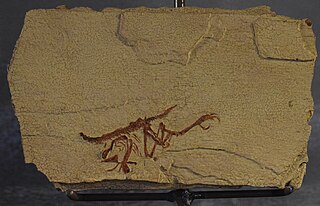
Iberomesornis is a monotypic genus of enantiornithine bird of the Cretaceous of Spain.
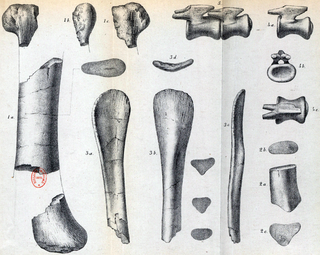
Hypselosaurus is a dubious genus of titanosaurian sauropod that lived in southern France during the Late Cretaceous, approximately 70 million years ago in the early Maastrichtian. Hypselosaurus was first described in 1846, but was not formally named until 1869, when Phillip Matheron named it under the binomial Hypselosaurus priscus. The holotype specimen includes a partial hindlimb and a pair of caudal vertebrae, and two eggshell fragments were found alongside these bones. Because of the proximity of these eggshells to the fossil remains, many later authors, including Matheron and Paul Gervais, have assigned several eggs from the same region of France all to Hypselosaurus, although the variation and differences between these eggs suggest that they do not all belong to the same taxon. Hypselosaurus has been found in the same formation as the dromaeosaurids Variraptor and Pyroraptor, the ornithopod Rhabdodon, and the ankylosaurian Rhodanosaurus, as well as indeterminate bones from other groups.
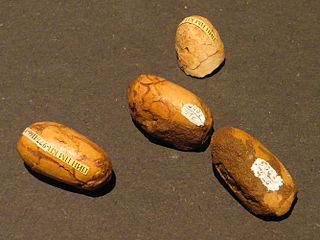
Gobipteryx is a genus of prehistoric bird from the Campanian Age of the Late Cretaceous Period. It is not known to have any direct descendants. Like the rest of the enantiornithes clade, Gobipteryx is thought to have gone extinct near the end of the Cretaceous.
The Xiagou Formation is the middle strata of the Xinminbao Group. It is named for its type site in Xiagou, in the Changma Basin of Gansu Province, northwestern China and is considered Early Cretaceous in age. It is known outside the specialized world of Chinese geology as the site of a Lagerstätte in which the fossils were preserved of Gansus yumenensis, the earliest true modern bird.
Mary Higby Schweitzer is an American paleontologist at North Carolina State University, who led the groups that discovered the remains of blood cells in dinosaur fossils and later discovered soft tissue remains in the Tyrannosaurus rex specimen MOR 1125, as well as evidence that the specimen was a pregnant female when she died.
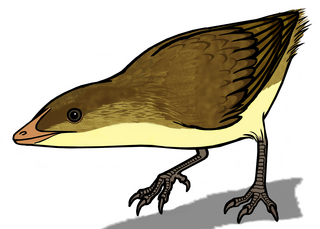
Eoalulavis is a monotypic genus of enantiornithean bird that lived during the Barremian, in the Lower Cretaceous around 125 million years ago. The only known species is Eoalulavis hoyasi.

Eoenantiornis is a genus of enantiornithean birds which lived during the early Cretaceous period. It is known from a single fossil specimen found in the Yixian Formation in Liaoning province, China.

Xiongguanlong is an extinct genus of tyrannosauroid theropod from the Early Cretaceous period of what is now China. The type and only species is X. baimoensis. The generic name comes from Jiayuguan City and the Mandarin word "long" which means dragon. The specific epithet, "baimoensis" is a latinization of the Mandarin word for "white ghost" in reference to one of the geological features of the type locality.

Elongatoolithus is an oogenus of dinosaur eggs found in the Late Cretaceous formations of China and Mongolia. Like other elongatoolithids, they were laid by small theropods, and were cared for and incubated by their parents until hatching. They are often found in nests arranged in multiple layers of concentric rings. As its name suggests, Elongatoolithus was a highly elongated form of egg. It is historically significant for being among the first fossil eggs given a parataxonomic name.

Macroolithus is an oogenus of dinosaur egg belonging to the oofamily Elongatoolithidae. The type oospecies, M. rugustus, was originally described under the now-defunct oogenus name Oolithes. Three other oospecies are known: M. yaotunensis, M. mutabilis, and M. lashuyuanensis. They are relatively large, elongated eggs with a two-layered eggshell. Their nests consist of large, concentric rings of paired eggs. There is evidence of blue-green pigmentation in its shell, which may have helped camouflage the nests.
Continuoolithus is an oogenus of dinosaur egg found in the late Cretaceous of North America. It is most commonly known from the late Campanian of Alberta and Montana, but specimens have also been found dating to the older Santonian and the younger Maastrichtian. It was laid by an unknown type of theropod. These small eggs are similar to the eggs of oviraptorid dinosaurs, but have a distinctive type of ornamentation.
Montanoolithus is an oogenus of fossil egg found in Montana and Alberta. They were probably laid by a dromaeosaur or a caenagnathid.
Parvoblongoolithus is an oogenus of fossil dinosaur egg whose small size and unusual shape suggest the possibility that it is a dwarf egg.
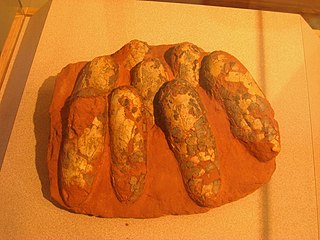
Elongatoolithidae is an oofamily of fossil eggs, representing the eggs of oviraptorosaurs. They are known for their highly elongated shape. Elongatoolithids have been found in Europe, Asia, and both North and South America.

Gobioolithus is an oogenus of fossil bird egg native to Mongolia. They are small, smooth-shelled, and elongated eggs that were first discovered in the 1960s and early 70s during a series of fossil-hunting expeditions in the Gobi desert. Two oospecies have been described: Gobioolithus minor and G. major. The eggs were probably laid in colonial nesting sites on the banks of rivers and lakes.
Dunhuangia is a bird genus, belonging to the Enantiornithes, which during the Early Cretaceous lived in the area of present China.

Feitianius is a bird genus, belonging to the Enantiornithes, that during the Early Cretaceous lived in the area of modern China. A single species has been named in the genus, Feitianius paradisi.
Mirusavis is a genus of Enantiornithes from the early Cretaceous of China recovered in the Yixian Formation. It contains a single species, Mirusavis parvus.


























